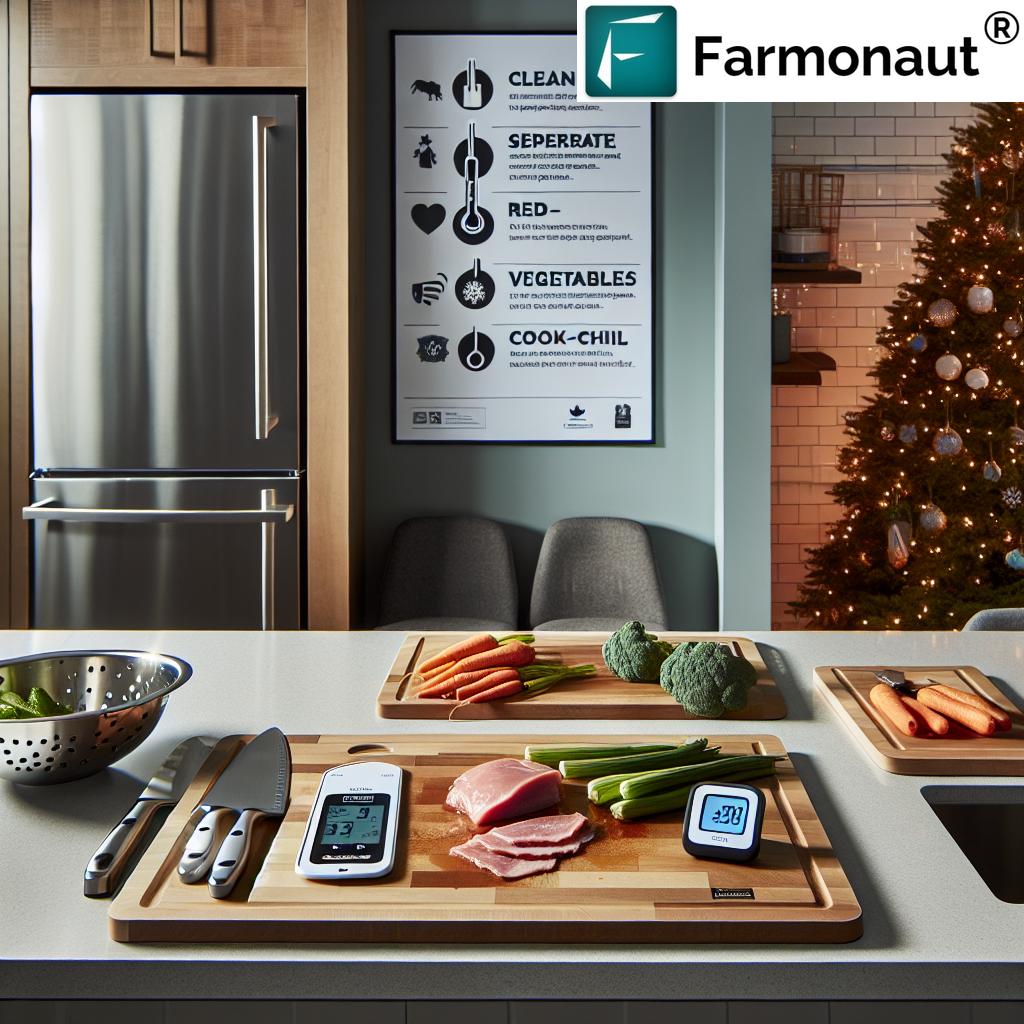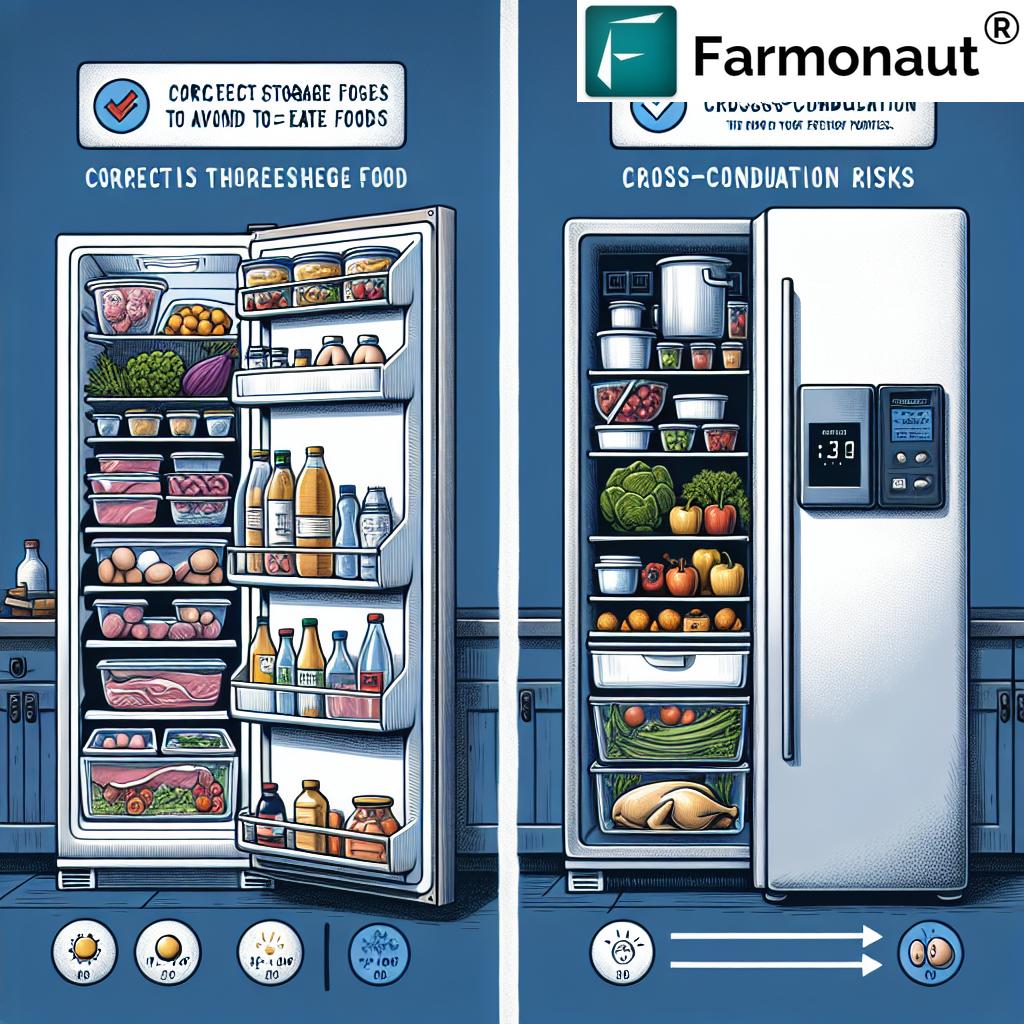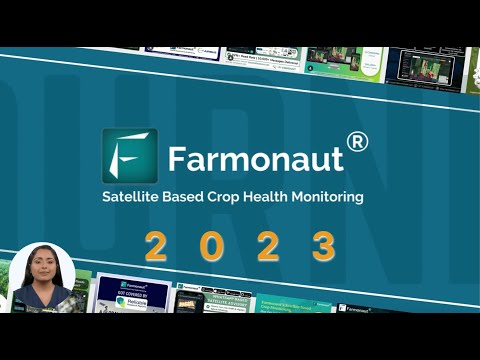Mastering Food Safety: Essential Tips for a Healthy Holiday Season in Canada
“Approximately 4 million cases of foodborne illness occur annually in Canada, highlighting the importance of proper food handling.”
Welcome to our comprehensive guide on mastering food safety during the holiday season in Canada! At Farmonaut, we’re committed to promoting health and wellness through innovative agricultural practices. While our primary focus is on satellite-based farm management, we understand that food safety begins at the source and extends all the way to your dinner table. In this blog post, we’ll explore essential tips to ensure your holiday meals are not only delicious but also safe for you and your loved ones.

The Importance of Food Safety in Canada
In Canada, food safety is a critical concern, especially during the holiday season when we gather to share meals and create lasting memories. With approximately 4 million cases of foodborne illness occurring annually in our country, it’s crucial to implement proper food handling practices to protect ourselves and our loved ones.
At Farmonaut, we believe that food safety begins on the farm. Our satellite-based crop monitoring system helps farmers maintain healthy crops, which is the first step in ensuring safe food production. However, the journey from farm to table involves many steps, and each one requires careful attention to prevent contamination and foodborne illnesses.
The Four Crucial Steps to Food Safety
To help you navigate the complexities of food safety, we’ve broken down the process into four essential steps: Clean, Separate, Cook, and Chill. These steps form the foundation of safe food handling and are crucial for preventing foodborne illnesses.
| Step | Description | Key Actions |
|---|---|---|
| Clean | Prevents spread of bacteria |
• Wash hands for 20 seconds • Sanitize cutting boards and utensils |
| Separate | Avoids cross-contamination |
• Use separate cutting boards for raw meats • Keep raw foods away from ready-to-eat items |
| Cook | Kills harmful bacteria |
• Use a food thermometer • Cook to safe internal temperatures |
| Chill | Slows bacterial growth |
• Refrigerate perishables within 2 hours • Keep refrigerator at 4°C (40°F) or below |
Let’s dive deeper into each of these steps to ensure you’re fully equipped to handle food safely this holiday season.
Step 1: Clean – The Foundation of Food Safety
Cleanliness is paramount when it comes to food safety. Proper cleaning practices help prevent the spread of harmful bacteria that can cause foodborne illnesses. Here are some essential cleaning tips to keep in mind:
- Hand Washing: Wash your hands thoroughly with soap and warm water for at least 20 seconds before and after handling food, especially raw meats, poultry, and eggs.
- Kitchen Surfaces: Clean and sanitize countertops, cutting boards, and utensils before and after food preparation. Use hot, soapy water followed by a sanitizing solution.
- Produce Washing: Rinse fruits and vegetables under running water, even if you plan to peel them. This removes surface dirt and bacteria.
- Avoid Cross-Contamination: Use separate cutting boards and utensils for raw meats and ready-to-eat foods.
Remember, clean water is essential for proper sanitation. At Farmonaut, we understand the importance of water management in agriculture, which translates directly to food safety. Our satellite-based soil moisture monitoring helps farmers optimize irrigation, ensuring crops receive clean water for healthy growth.
Step 2: Separate – Preventing Cross-Contamination
Cross-contamination is a leading cause of foodborne illness. By keeping raw foods separate from cooked or ready-to-eat items, we can significantly reduce the risk of bacterial spread. Here are some key practices to implement:
- Grocery Shopping: Keep raw meats, poultry, and seafood separate from other foods in your shopping cart and grocery bags.
- Refrigerator Storage: Store raw meats on the bottom shelf of your refrigerator to prevent juices from dripping onto other foods.
- Preparation: Use different cutting boards for raw meats and produce. Consider color-coding your boards for easy identification.
- Utensils: Never use the same utensils for raw and cooked foods without washing them thoroughly in between.
At Farmonaut, we apply similar principles of separation in our agricultural practices. Our satellite imaging helps farmers identify different crop areas, enabling them to manage pest control and fertilization more effectively, reducing the risk of cross-contamination in the fields.
Step 3: Cook – Ensuring Safe Internal Temperatures
Proper cooking is crucial for killing harmful bacteria that may be present in raw foods. Different types of food require different cooking temperatures to ensure safety. Here are some guidelines to follow:
- Use a Food Thermometer: This is the only reliable way to ensure foods have reached a safe internal temperature.
- Poultry: Cook whole poultry to 82°C (180°F) and poultry pieces to 74°C (165°F).
- Ground Meats: Cook ground beef, pork, veal, and lamb to 71°C (160°F).
- Eggs: Cook until both the yolk and white are firm, not runny.
- Leftovers and Casseroles: Reheat to 74°C (165°F).
Remember, color is not a reliable indicator of doneness. Always use a food thermometer to check internal temperatures.
“The four crucial steps for food safety—Clean, Separate, Cook, and Chill—can significantly reduce the risk of foodborne illnesses.”
Step 4: Chill – Proper Food Storage
Refrigeration slows bacterial growth, which is why proper chilling of foods is essential for safety. Follow these guidelines to ensure your foods are stored correctly:
- Refrigerator Temperature: Keep your refrigerator at 4°C (40°F) or below.
- Two-Hour Rule: Refrigerate perishable foods within two hours of cooking or purchasing. In hot weather (above 32°C or 90°F), reduce this time to one hour.
- Thawing: Never thaw foods on the counter. Use the refrigerator, cold water, or the microwave.
- Leftovers: Use within 3-4 days or freeze for longer storage.
At Farmonaut, we understand the importance of temperature management in agriculture. Our satellite-based monitoring provides farmers with temperature data, helping them protect crops from extreme conditions and maintain optimal growing environments.

Special Considerations for Vulnerable Populations
Certain groups are at higher risk for foodborne illnesses and should take extra precautions:
- Pregnant Women: Avoid unpasteurized dairy products, raw or undercooked eggs, raw sprouts, and deli meats unless heated until steaming hot.
- Young Children: Ensure all foods are cooked thoroughly and avoid honey for infants under one year old.
- Elderly: Pay extra attention to food safety practices as the immune system weakens with age.
- Individuals with Compromised Immune Systems: This includes those with chronic illnesses like kidney disease or undergoing treatments that affect the immune system.
For these groups, it’s especially important to adhere strictly to food safety guidelines.
Holiday-Specific Food Safety Tips
The holiday season brings unique challenges to food safety. Here are some specific tips to keep in mind:
- Turkey Preparation: Thaw turkey in the refrigerator, allowing 24 hours for every 4-5 pounds. Never thaw on the counter.
- Stuffing Safety: Cook stuffing separately from the turkey for best safety. If stuffing the bird, do so just before cooking and ensure it reaches 74°C (165°F).
- Buffet Precautions: Keep hot foods hot (above 60°C or 140°F) and cold foods cold (below 4°C or 40°F). Replace serving dishes rather than adding fresh food to a dish that’s been sitting out.
- Traveling with Food: Use coolers with ice packs for cold foods and insulated containers for hot foods.
By following these guidelines, you can ensure that your holiday meals are not only delicious but also safe for all your guests.
The Role of Technology in Food Safety
At Farmonaut, we believe that technology plays a crucial role in enhancing food safety from farm to table. Our satellite-based farm management solutions contribute to this in several ways:
- Crop Health Monitoring: By providing real-time data on crop health, we help farmers identify and address issues early, reducing the risk of contaminated produce.
- Soil Moisture Management: Proper soil moisture levels are crucial for crop health and can affect the safety of the final product. Our technology helps farmers optimize irrigation practices.
- Weather Forecasting: Accurate weather predictions allow farmers to protect their crops from extreme conditions that could compromise food safety.
While our technology focuses on the production side, it’s important to remember that food safety is a continuous process that extends all the way to your kitchen.
For those interested in learning more about our agricultural technology solutions, visit our API Developer Docs or explore our API for detailed information.
Integrating Food Safety into Your Holiday Preparations
As you plan your holiday meals, consider incorporating these food safety practices into your routine:
- Meal Planning: Consider food safety when planning your menu. Choose dishes that can be prepared safely given your kitchen setup and equipment.
- Shopping: Buy perishable items last and head straight home to refrigerate them.
- Preparation Schedule: Plan your cooking schedule to ensure hot foods stay hot and cold foods stay cold until serving time.
- Guest Communication: If guests are bringing dishes, provide them with food safety guidelines, especially for transporting and storing their contributions.
Remember, food safety is everyone’s responsibility. By working together and following these guidelines, we can ensure a healthy and enjoyable holiday season for all.
The Future of Food Safety
As we look to the future, the integration of technology in food safety practices continues to evolve. At Farmonaut, we’re excited about the potential for satellite technology and AI to further enhance food safety measures:
- Traceability: Our blockchain-based solutions can help track food from farm to table, improving transparency and safety throughout the supply chain.
- Predictive Analytics: By analyzing satellite data and weather patterns, we can help predict and prevent potential food safety issues before they occur.
- Sustainable Farming Practices: Our technology promotes sustainable farming methods, which often lead to safer, healthier produce.
While these advancements are promising, it’s important to remember that basic food safety practices in the home remain crucial. Technology can support and enhance our efforts, but it can’t replace proper handling, cooking, and storage practices.
Conclusion: A Safe and Happy Holiday Season
As we wrap up our guide to mastering food safety for the holiday season in Canada, let’s recap the key points:
- Follow the four crucial steps: Clean, Separate, Cook, and Chill.
- Pay special attention to the needs of vulnerable populations.
- Implement holiday-specific safety measures for traditional dishes and buffet-style meals.
- Embrace technology to enhance food safety, from farm management to kitchen practices.
- Remember that food safety is an ongoing process that requires vigilance at every step.
By incorporating these practices into your holiday preparations, you can significantly reduce the risk of foodborne illness and ensure a safe, healthy celebration for you and your loved ones.
At Farmonaut, we’re committed to promoting health and wellness through innovative agricultural practices. While our focus is on farm-level solutions, we recognize that food safety is a collaborative effort that extends from the field to your dining table.
For those interested in learning more about our agricultural technology solutions and how they contribute to food safety, we invite you to explore our offerings:
Let’s work together to make this holiday season not only joyous but also safe and healthy for everyone. Happy holidays from all of us at Farmonaut!
FAQ: Food Safety During the Holiday Season
Q: How long can I keep leftovers in the refrigerator?
A: Generally, leftovers can be safely stored in the refrigerator for 3-4 days. Always reheat leftovers to an internal temperature of 74°C (165°F) before consuming.
Q: Is it safe to eat food left out overnight?
A: No, it’s not safe to eat perishable food that has been left out at room temperature for more than 2 hours (1 hour if the temperature is above 32°C or 90°F). Bacteria can multiply rapidly in the “danger zone” between 4°C and 60°C (40°F and 140°F).
Q: Can I stuff my turkey the night before cooking?
A: It’s not recommended to stuff a turkey in advance. For safety, stuff the turkey just before cooking. Alternatively, cook the stuffing separately for optimal safety and even cooking.
Q: How can I safely thaw a frozen turkey?
A: The safest method is to thaw the turkey in the refrigerator. Allow 24 hours of thawing time for every 4-5 pounds of turkey. Never thaw a turkey on the counter at room temperature.
Q: Are there any foods pregnant women should avoid during holiday meals?
A: Yes, pregnant women should avoid unpasteurized dairy products, raw or undercooked eggs, raw sprouts, and deli meats unless heated until steaming hot. They should also ensure all meats are cooked to safe internal temperatures.






